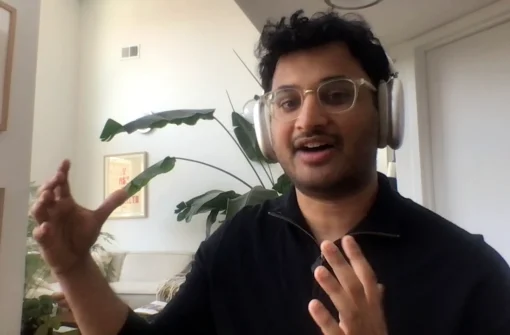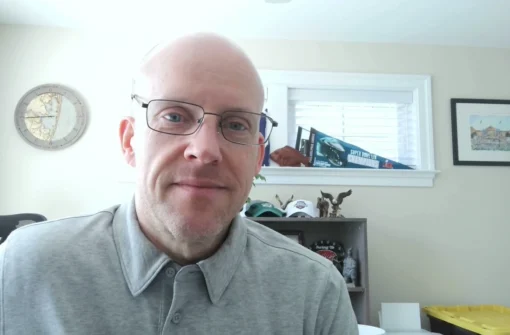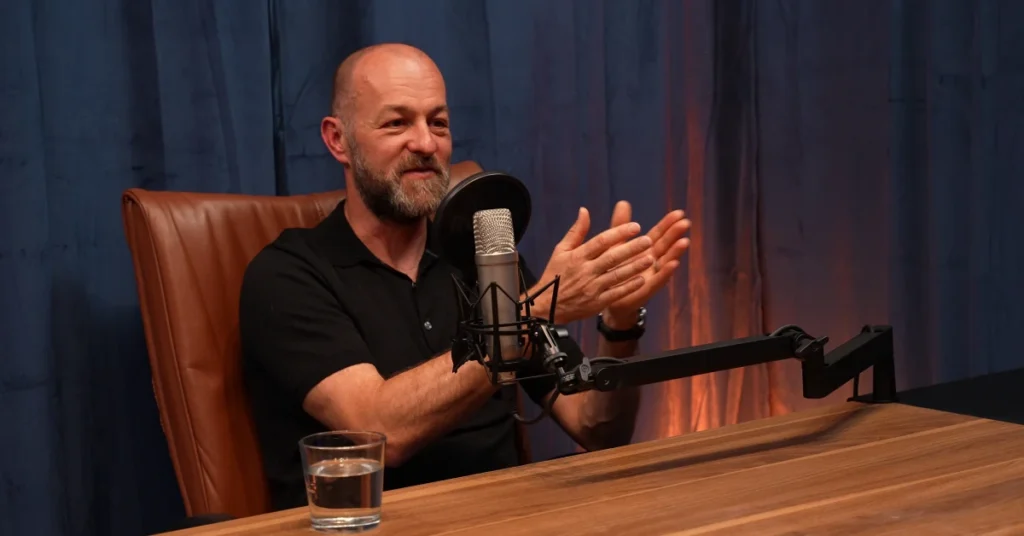
The Art Of Experience Design With Glen Finch
Digital innovations are more than just faster delivery time or better software interface. Above anything else, experience design must be taken into account for these solutions to be truly impactful. In this episode, Alexandre Nevski chats with Glen Finch about what it takes to deliver human-centered innovation in an era of rapid technological change. Glen discusses how to design digital solutions not just by focusing on what is happening on their screens but even beyond it. He explains how to successfully craft such customer-based designs without setting aside company goals and expectations. Alexandre and Glen also talk about the importance of human intervention in today’s continuous rise of automated systems and artificial intelligence.
Pega® is a trademark of Pegasystems Inc. Please visit https://www.pega.com to learn more.
Transcript
What goals does your organization have for its digital transformation? Often, we focus on efficiency gains, faster time to market, and stricter compliance, but these dry business terms tell only half of the story. My guest is Glen Finch. He makes a passionate argument that while solutions may be digital, success can only be achieved if organizational goals are matched to the desired outcomes of their people. Together, we explore the art of designing human experiences in an era of rapid technological change.
Stick around to know how an expert uses empathy and creativity to craft moments that matter to deliver differentiated yet sustainable innovation. For many years, Glen drove cross-functional teams to leverage design thinking with a hands-on approach. As Senior Director of Innovation Design at Pegasystems, he is widely recognized for his strategic skills, building successful human-centered practices, and establishing a design culture. Without further ado, here’s my conversation with Glen Finch.

Glen, welcome.
Thank you.
It’s great to have you. I’ve interviewed several Pega experts for this first season, but I believe you have a very unique and important perspective. When I was at Pega, I think you were the first UX person I met at the company. Can you start by sharing with our audience what was it like to be a designer at Pega back then?
If memory serves me well enough. As you said, I was the second hire in that space in the professional services community and the first one that worked in the major region. When I started very much tasked with being a hands-on role, but it quickly made me realize that in that space in Pega and a lot of companies like that, the focus was on the technology side and making sure that we understood what the business was trying to achieve.
There wasn’t much consideration of the humans that were going to be the end of those experiences. I had to spend a fair amount of my time helping to orient my colleagues as to what the role was and what value that was intended to bring, and then also to start to socialize and to make our clients aware of that as well.
I don’t like using the word education, particularly in that sense, but certainly to raise their awareness and help them understand where it fits in within that overall spectrum of engagement and developing solutions that span across kinds of business communities. Particularly when it’s something that’s not going to be directly consumer-facing itself, but it’s going to service those employee experiences. Ultimately, those are still part of how customers or organizations get serviced.
Yes, and I was one of them. Wasn’t I?
Yes, you were. You are very much one of those.
I remember some long brainstorming sessions where we were mostly just looking for ways to deliver a great UX but without customizing the platform. I felt like it just added a lot of value. Bringing those two perspectives together was very useful, wasn’t it?
Yes, I think. You raise a good point. Of course, you can completely tailor or bespoke experience based on your understanding of who the consumer of that product or of that solution is going to be. Like most things, the more and more effort you put into it, you start to hit a point of diminishing returns where you might go from a 90% great experience to 95%. From a 95% great experience all the way to 100, you’re probably going to put more than double that effort in for more than that 5% gain.
They reach a point where you’re trying to balance and evaluate the propensity of that organization and the actual viability of them to spend that time, effort, and money ultimately. Is it worth them doing that for the experience they want to deliver and for the difference that it will make both to those consuming the experience and the organization itself?
It is not black or white. It is a pretty structured discipline where, just like you said, you’re looking for the right balance. How would you say that this discipline has now evolved at Pega since then? I feel like there are of course a lot of designers, but their role seems to have changed and they seem to have taken the lead role when it comes to innovation. How did that happen?
That’s an interesting journey. I think some of that was down to parts of our leadership and how they saw people within those spaces working. If I step back and take a bigger picture, to your point, when we started, you were very much concerned with the in-application experience. How does whatever you’re trying to do manifest itself on a screen?
For a digital solution for a software company, it’s usually a screen. Perhaps a little bit more now, including voice and a few other things, but once upon a time, it dominated around a screen. Naturally, that design effort tends to lean towards creating user interfaces. Where do we place buttons? What is the layout structure? How do we architect the information and the data we want to present to users?
Over time, we were able to mainly have clients see the value that so many other things take place outside of that particular application that influence their experience. That might be if they’re going from a paper form to a digital form or they’re still going to have a piece of paper next to them. It’s important to understand how that information is being presented on that paper form to translate it into a digital experience.
Ultimately, you have mental models that people build in their minds. You often see them manifested in ways in terms of how people do workarounds, perhaps with sticky notes and things, but understanding how they form those mental models in their minds to interact with systems stretches beyond what you’re going to design at that screen level, certainly on a screen by screen basis. I think the times when we had great successes helped elevate those clients to understand that the totality of the experience will be more than just the sum of the parts of the screens and the data and information that’s presented.
The broader perspective is the unique aspect of that role.
I think that’s a big part of it. Balancing often what an organization wants to achieve is not perfectly always aligned with what an individual that’s working on that may be trying to achieve. That’s very evident perhaps in a B2C consumer situation of a company wants to sell something and a consumer may or may not be looking to buy something.
What an organization wants to achieve and what the customers want to achieve is not always aligned.
That also extends to people working within an organization. My personal objectives are not always what the company is trying to achieve, but I will have ambitions myself of what I’m trying to do. Some of that may be around just wanting to do a good job or taking care of a customer because I feel some connection with what they’re doing and have a passion for trying to help them.
I think it’s important to recognize those and understand where those frictions sometimes occur between perhaps a high-level business metric and what people are doing and how they’re thinking about getting that work done and trying to find that balance between the two that helps create a more win-win situation.
The term that when we were preparing for the interview, you said, is commonly used nowadays as, “Experience Design.” We’ll go into what it is exactly, but a bit later. I just want to finish with the introduction understanding is everyone who is a designer now working in experience design?
No, design is a big and broad spectrum. I often refer to it as something like Design when I’m talking about all the spheres that encompasses, but not everyone is either suited to or wants to work in that large space that you would say encapsulates all of the experience design. Some people are good at visual layout design or interaction design at the screen level.
Some people are good at thinking about how we structure information that needs to be consumed. There are very different aspects within the design space, stretching all the way through visioning and storytelling, right down to the positioning of visual layout elements, and getting very specific about making sure that those meet standards.
Probably, the average layperson wouldn’t be able to see and point to where those differences are, but overall, when you start to build up multiple systems, it encompasses someone’s understanding of how to interact with systems. Those norms start to get established and if you don’t have that level of coherency in the design language, almost, if you will.
You will start to see that you will not get the overall input that you want and the overall desired outcomes. A lot of our product community works in that second space, helping to shape a visual design language and a design system that can be used by other people and is easy to pick up and apply to create those experiences.
Echoes Of Innovation
Glen, for this segment, we use storytelling to bring authentic insights to our audience. I always advise my guests to use discretion with names and specifics. Honor confidentiality agreements, of course, to respect people’s privacy. With that in mind, can you think of maybe a story that you can share that would illustrate the importance of experience design?
We did some work a while back that was in a space that’s perhaps not typical for what we do, but it was around funeral homes and mortuary care, looking at that whole experience about a very pivotal moment in people’s lives, which is dealing with death and mortality.
There is a service there that needs to be executed, done effectively, and done well and efficiently for that organization to be able to run well. Also, they need to be able to satisfy their customers who are going through difficult moments in their lives at the end of the day. They had been using Pega as a solution to help them manage that effectively so that they could have standardized approaches that ensure excellent care for their customers.
One of the challenges we faced was while they were executing their delivery in terms of hitting agile sprint goals. There was a big disconnect, and some resistance among the community that would be adopting that was starting to see. That spanned across from funeral care home managers, funeral directors, and ultimately down to the people who were carrying out some of the work in preparing a body ready for whichever type of service it would be.
To help us grasp the context, who were the people involved? You came from the Pega side, of course.
Yes. We had the client, and then there was a partner involved who was executing the delivery and providing a lot of support for an organization that didn’t have the largest IT network. It did have some, but they were helping support a lot around that.
Was it like an IT project or a business-led project? I know there isn’t a black-and-white description, but it’s always nice to understand who’s championing the introduction of technology.
This was a business-led initiative in terms of the organization’s getting to a size where their previous structures and systems no longer supported them. Throughout growth and some acquisitions, they ended up with non-standardized working practices or workflows and systems that didn’t support their modern need in terms of understanding that excellence of care was going to be delivered.
You come in and you are there from the beginning. You’re saying that they’re on their way.
They had already started their journey.
What were the issues that you saw from the experience design side of things?
From the experience design side, we were seeing things getting built, but that understanding of the context of use and the situation and understanding of what was, as I said, in those people’s minds as they were going through that. If I’m a funeral director, what is going through my mind when I’m dealing with people in this incredibly sensitive moment in their lives?
Experience design takes into consideration what is happening in people’s minds as they go through a particular software or digital solution.
In some cases, very soon after a bereavement, a body needs to be collected to be taken away. It’s an incredibly sensitive area where empathy is also like obviously very important. We did see that they had some design effort applied, but when we were looking at it, we looked at the personas they had generated and while they did try and paint a human-like picture or snapshot of what that role was, some of the important things were missing.
The person detailed quite a lot of tasks that needed to be done and what needed to be carried out did have some information about who this person might be in terms of their background, but it missed making a connection for the development team in understanding what the context of those situations would be like.
We managed to go out and spend some time observing and interviewing some of the people in those roles to try and build them out so that they were less just about tasks and duties, and helped create a clear understanding for the teams that were going to be building the solution, what those roles looked and felt like in practice.
I’m guessing that it wasn’t the easiest of tasks in the sense that, no, of course, you still do the same thing that you would do with another organization, but given the context, I’m guessing that the reason why maybe no one had done this to that level before was that it wasn’t the most comfortable of things.
I think not comfortable and that’s your company, your organization. There’s a degree of reticence about wanting to let people loose in the zoo if you were. There was a lot of making sure we dealt with things tactfully, and they understood how we were going to approach this and that it would be non-intrusive. While we desire to get the greatest amount of first-hand knowledge possible, one of the things we specifically didn’t suggest was having a designer ride along with a funeral director on a first call to take notes while some family is going through a life-changing experience.
That’s something we specifically didn’t do. It would be completely inappropriate. We interviewed funeral directors and went through a process of asking them to reflect on their experiences. In that interview, rather than just ask them generically, you would ask them to say, “What was the last call that you went on? Talk us through that. Talk to us about what it felt like and how it was. How many people were there? What were you dealing with?”
We gave them very specific questions to make sure that the information we were getting back was directly relatable to an experience that they had fresh in their mind rather than asking them to generalize. I think one of the great things that came out of that experience is that while the company was looking to drive some greater standardization to help maintain the excellence of care, one of the drivers behind that was we have a lot of handwritten notes, which can sometimes lead to interpretation errors when someone else is reading them or things get lost. They wanted to digitize this.
It is not unique to this industry, and one of the ways they thought would be beneficial for doing that was to have a tablet or a phone of some form to take that information. One of the challenges that we managed to uncover through this process was the mental mindset of the funeral directors, which was why they always carried a leather-bound notepad.
They were very concerned with the families or the loved ones feeling that they might perhaps be engaged in something else on their phone, texting a friend, or on social media. They never wanted to convey that it was very important for them to make those families and their loved ones feel that they were 100% in their moment, attentive to them, and very respectful and aware of their situation.
It didn’t negate that a digital solution was possible, but it did mean that we were able to make some recommendations that stretch just beyond what the screen looks like to say that if you have nice covers created for a tablet, perhaps the company’s name in on there, it becomes more evident that actually what they’re doing is Workspace at that moment and it is a work tool rather than their text and their loved one about perhaps what they’re going to have for dinner that night.
It makes sense to differentiate between this work tablet and this work device. When we were preparing this, you told me that some of the techniques that you use, for example, for mapping personas, weren’t standard in a way because normally, a persona is not a concrete person. It’s more of an amalgamation, something that is symbolic. In this case, you told me that you went and included the specific people for persona mapping. Can you explain a bit more about what point that makes sense? You’re just normally following standards, but in this case, I guess it’s the situation, the context, and the type of work that people do. What was it?
In this instance, the type of work that they do and the realities of what they do were important in helping the delivery team get that level of empathy and understanding about what that meant that was paramount. The majority of the information in there that we gathered was a synthesis of multiple inputs of disseminating data and then the contextual and qualitative information that we gained from the interviews.
All of that followed a standard persona format. Where we diverged was rather than using some kind of stock photography to represent the person in terms of bringing a face to life, we needed to convey what that person in that role looks like. The simplest form was probably the care team that undertook the removal of the body, so it was important to show that they were wearing blue latex gloves.
The delivery team needed to understand that while that didn’t mean that you couldn’t use a touchscreen, certain considerations had to be built in there, like they’re dealing with a body with fluids involved. Sanitation becomes a concern, and touchscreens are less sensitive when gloves are on. Now, we need to take that into account, saying the button size might need to be slightly larger when we have to do this because the tactile nature is not going to be as accurate.
All of that information is so much easier conveyed through a picture. In this case, a picture really spoke 1,000 words. I think the one that struck the team home most from the feedback I got was when we had the preparation of the body for embalming. Again, the idea was that we needed to capture this information digitally, but when you see someone completely dressed out in protective gear, it’s necessary to undertake essentially what a procedure is.
The idea of them being able to stop every few moments, either clean their gloves or remove their gloves to capture some information system and carry back on, is not going to get the efficiencies you were hoping to try and drive. You might get some standardization, but you were going to lose out on the flip side with the interruptive nature of that.
There would be a lot of pushback, I’m sure.
Yes, it may just shift our thinking to say something like an extra development effort to suggest that capturing through voice is going to be far more beneficial for you. Even though the project will change focus and scope a little bit, That uplift beyond what might be considered a standard back-office operational procedure was incredibly warranted in terms of the business value that would be deemed on the other side. That was a big shift in terms of understanding the scope change is relatively easier to think about than the estimation of what will the impact or the value be delivered on the solution on the other side. It’s not impossible, but those are often harder to do, particularly when you have people that are involved.
Once you’ve communicated those observations and shared the information with the partner and the rest of the team, how quickly were they able to use that information to improve both the solution but especially the experience of the people?
I would say there’s a multifaceted answer. Some of this immediately resonated at the leadership level, as they were perhaps seeing disconnects. As I said, their delivery schedule wasn’t the challenge. The challenge was that they didn’t feel like they were achieving the goals or the outcomes they intended in those timeframes. I think at that level, some of that immediately connected.
When you have to now try and work through the motions that you have as a delivery organization, that takes time for that to be out to cascade for the teams to get back to their operating procedures and their regular rate cadence for being able to work through a backlog and deliver for testing and ultimately adoption. It took a little bit longer for that to cascade down. In some cases, there were challenges because it was a change.
You’re instituting a change when, for some people, they feel like they are operating effectively already, but I will say it managed to go from that top level right the way down to the individual developers, which ultimately means that we are succeeding in making those pivots that we need to based on learnings that we acquire, which is what agile should ultimately be about.
The story you’ve shared with us is extremely powerful but also unusual. Does that mean that this is a very specific case or is this a relatively good illustration of what generally happens when experience design is undertaken for the first time?
I think this accentuates the situation because it’s very easy to retell and for people to understand why having empathy would be important and why having those people be able to make those changes in how they get their work done. If they don’t adopt it, then it doesn’t happen. You could see why there might be some resistance to adopting things that are new when you’re in such circumstances where people are very vulnerable. It accentuates it. We have other examples that are far more in the traditional space than you would imagine. Uncovering something that’s perhaps latent or just the pieces that haven’t been connected before to understand how people interact can drive quite a big change.
Blueprints Of Innovation
Thank you very much, Glen. If you found those tales of innovation valuable, please like and subscribe to help us share with more people. Glen for this second segment. It’s a little bit shorter. I aim to focus on tools and methods and give our audience a sense of the technical terms or some of the more advanced stuff that we’ve mentioned. I would want a description of the discipline in itself and the experience design you’ve illustrated. What does that encompass? Where does it come from and how should people treat it in their organization?
I think one of the important things that I often stress is there’s always a person at the end of every experience. I know that nowadays, everyone’s automating and looking to use AI, but still, the person buying that mobile phone plan is a human being. The person who needs health care or health care coverage is a human. No piece of AI is taking out a loan for a mortgage to buy a house.
There is always a person at the end of every experience. Despite the rampant automation nowadays, human beings are still involved in some way.
There’s a human at the end of every one of those experiences. No matter how much we look to streamline and automate that, ultimately, there’s a customer that needs to be serviced. I use the term customer to both mean an external to the organization customer but also an internal customer. Anyone who is consuming that product or that service is a customer of it.
Again, no matter how much we automate, there’s still someone who will ultimately want to be able to see and ensure that end customers and consumers are being serviced appropriately. There’s always at least one human, usually two or more, involved in that. When we think about that experience design, it’s the focus on the person who is going to be the consumer of that service or that product.
It’s understanding that the totality of their experience extends more than just the touch points of interaction with a particular system. It incorporates how they think, what else they’re doing, and what might be the moment or the situation in their lives that they’re going through. Touching both of those examples is very different, but both of them deal with significant moments that matter in people’s lives.
I think it’s important to understand that successful companies nowadays focus on designing those moments that matter. No one’s particularly interested in having a single transaction. Everyone’s looking to build some level of customer loyalty, and feed customers or continue your customers through some as a service.
We must be able to think about designing those moments that matter for people because those are the ones that help shape how they perceive us as a brand, the ones that help shape their opinion of you, whether they’re going to share that with friends. We all know that a recommendation from a customer goes much further than any advertising recommendation would do. Understanding where it fits inside of the organization helps inform your product strategy.
It helps you reinforce your brand beyond those very obvious, tangible branding moments, such as any type of marketing you’re doing or your online presence. All of those are important, but understanding what shapes those moments that matter with clients helps create that totality of experience that creates loyal customers who will come back to you time and time again and refer you to other people. Who are hopefully making their lives better in some small way while at the same time servicing your organizational skills?
I remember, in one context, those terms being a moment of truth and then sometimes being a moment of misery. What I’m hearing here is that the experience design discipline is about focusing on these moments that matter, as you call them, but still, of course, taking that within the context of what the organization is trying to achieve, but ensuring that it doesn’t inadvertently create a moment of misery just because it was focused on automation.
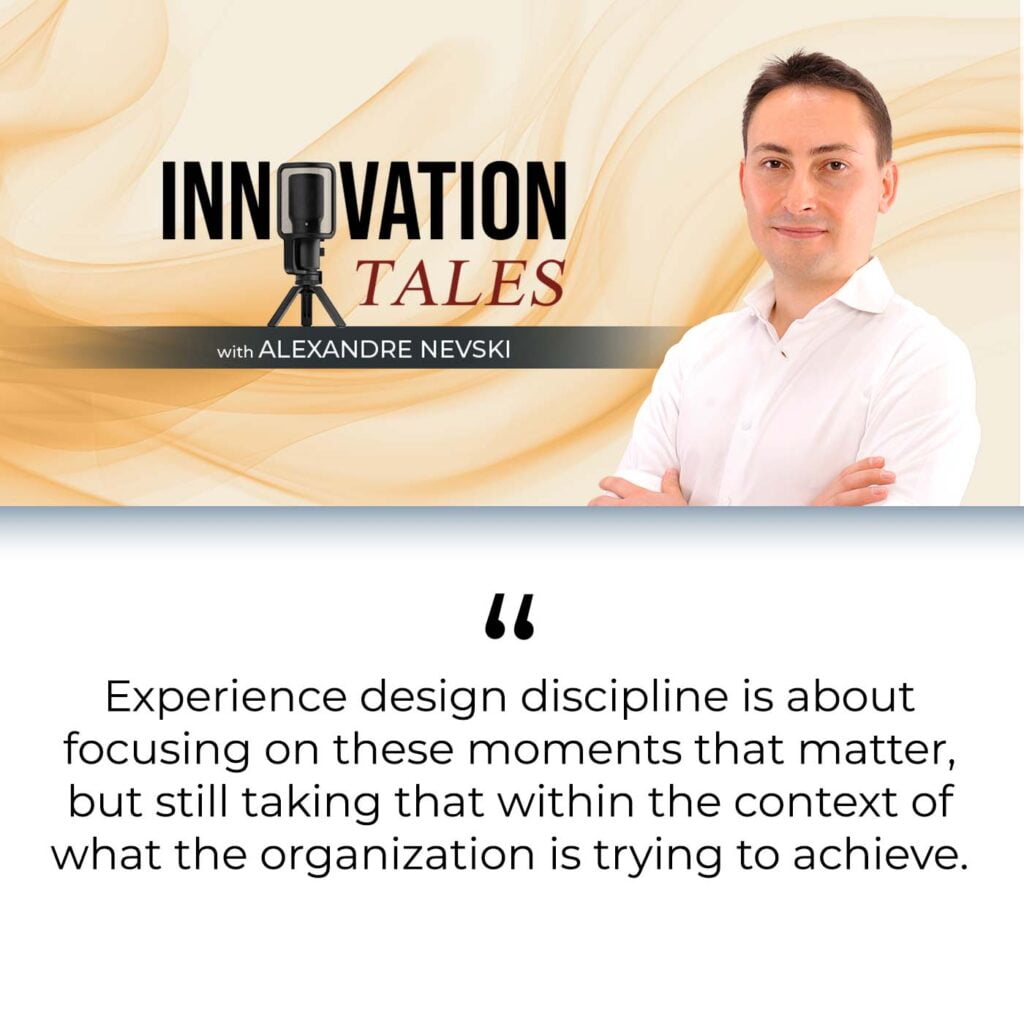
I think it’s important to recognize. You use those terms, moments of truth and moments of misery. I think it’s almost folly for an organization to try and create some heightened moment of delight continually with customers. One is that it’s never going to be sustainable for an organization to be able to operate that way, but also, as human beings, when everything’s at that level, nothing stands out and it doesn’t create any connection.
It is almost folly for an organization to try and create heightened moments of delight continually with customers.
If you had a piece of music that was always popped out.
Yes, like that. I’m certainly not saying that we should try to create moments of friction or frustration with our customers, but understanding what the important one to amplify would be, whereas just something that’s perfectly okay is good enough. It’s always a challenge for companies to understand where to invest some of that effort.
I think I’m not the biggest proponent of NPS as a solid metric for understanding customers, but I do think that it highlights one important thing, which is that 9 and 10 create the impact. If, as an organization, you were focused on across your spectrum, let’s say you had a large amount fall in the four to five category, a team could shift them up to 7 and 8.
Metric-wise, that looks like a big shift, but what does it do in terms of that customer sentiment? I think that the interesting thing about NPS is that it would be seen as a net neutral, no change. Now, that’s quite harsh for a team to take because you have made a shift, but perhaps focusing on some of those four and five moments was not where we should be measuring. We should have been looking at the ones we can shift from 8 to 9 or 10.
I think it’s important to understand that NPS, for me, only has value when you have people reflect on a specific moment that they’re able to recollect, which is why it often comes to the end of a customer service call or at the end of some survey. Trying to have them reflect on the entirety of an experience with an organization is very difficult, but having them reflect on a last moment or experience, you can get some interesting information back.
Innovator’s Playbook
It’s a bit more specific. That’s great. You brought us to the third segment, which is about practical advice. You’ve already used the NPS as an example. I like how you’ve already started describing experience design, not just as a structured discipline that an engineer would do, but we’ve already mentioned how you wouldn’t want a piece of music to be too much all the time, but the contrast is nice. It sounds like this is also something that you would want to do with the experience you’re providing so that some things stand out. At least, that’s how I heard you. Was that what you meant?
Yes, that’s absolutely what I mean by trying to design those moments that matter. Understanding what will be important, but then specifically thinking about designing a standout moment for a customer. That might be an area where perhaps the most cost-effective or the easiest-to-scale thing is not necessarily the right thing to do.

Counterintuitively, sometimes it could be like creating this experience. It is worth slowing down or spending more effort here because that is a valued moment by the person who’s going to be consuming. There are some examples out there that are not my work examples. One that I read fairly recently was about hotels in Hollywood, LA. They were looking at which ones received the best reviews and the highest reviews.
Quite notably, along with the Four Seasons and all the ones that you would expect to be in there, there’s a fairly small, quirky, almost motel-like. What it does have is a few things that stand out. Down by the swimming pool area, there’s a popsicle hotline. You call through, and they will bring you out a popsicle that you want. Now, it’s a little bit of theater because, obviously, they could have a self-service freezer right there and you just go and help yourself to a popsicle.
The net result of what you get would be the same, but it is not a crafted experience of you just having to go and pick something up compared to calling and someone bringing out a popsicle specifically for you. Thinking about moments that matter. I don’t know whether that one ever would have occurred to me, but looking at those reviews for people who went to that hotel, it came up time and time again as one of the standout features was the Popsicle hotline, which is curious. That is a clear example of the extra human effort involved there. They’re slowing down the service that would happen there rather than someone being able to get it themselves. That moment helped create an impactful moment for those who made a difference rather than just having something available.
Let’s try and help our audience project themselves. Let’s imagine we’re advising a business leader and they are going through a transformation. How do they then organize themselves, help their teams select, and create space to create those that contrast with what we were just discussing? Of course, maybe we don’t know how the popsicle hotline came about, but how does it work in your experience?
I think one of the important things to recognize is when you look across traversing entire journeys for customers and the number of people they either directly interact with that they’re aware of or what happens behind the stage that they don’t see between those touchpoints, there’s a lot there. It’s not tenable for organizations now to say, “We’ll spend the human effort investigating all of these moments to find out which are the ones we should focus on.”
The world is simply moving too fast. Change is happening too quickly. To do that nowadays, perhaps paradoxically enough, you’re going to hear the designer guy saying that data is important for us to understand where we should invest some of that very valuable human effort because it’s precious and scarce.
Having access to your data and being able to interrogate and understand what it’s telling you gives you a good understanding of where something might need attention and focus. To some extent, it’s going to tell you what’s going on on the surface but to truly get to an understanding of what’s going on and why it’s going on. That’s where human effort is valuable.
We always try to look at things by saying, “We want to make sure that any findings that we get don’t call them a proper insight until we have more than one reference point of information. That should span both qualitative and quantitative, behavioral and attitudinal. If you are seeing something in your online usage metrics, that’s one point.
Now, you want to be able to find something else that leads you to the same point that perhaps comes from someone’s experience with your customer complaints that they’re putting down qualitatively. I think it’s interesting now, the space that we’re moving into where lots of that very large unstructured data that we got before that fell into the qualitative realm couldn’t do a great job of interrogating it.
Generative AI starts to allow teams to make sense of far larger sets of information, whereas before, we’d have had to either cast that to one side or be very selective in the things we picked and perhaps we need to do some direct observation or interviewing. Now, we can get a lot further from the information side, and the use of technologies allows the teams to get that last step of deep information from a much smaller effort of actual human-to-human investigation.
It sounds like you have to be good at understanding the experiences you provide, the services that you’re offering, and how they impact people’s experiences, and some of it is quantitative. A lot of data, but understand and get a Heat Map in a way. From there, connect the dots and see if there is something that repeats. I guess that’s where you need expertise. You need people who have done this before.
It’s a multidisciplinary approach. Having people who can bring that data analytics side is useful. Having people who are good at doing synthesis between different types of information, and then collaboratively having both of those groups, knowledge, and experience, be able to go through a process of making sense of that information. As I said, I call it an insight until we’ve collected those learnings or data points and find commonalities or similarities in them.
Go through a sense-making process to try and help classify what that might be telling us. We can then ultimately try to set it up as a hypothesis because even the best information doesn’t always give you the full picture the minute you try to change something. In each of those situations, the next thing to do would be, “Okay, what’s the smallest experiment we can run to understand whether our hypothesis is correct and we wish to proceed?”
We’re in between both the artistic world where subjectively, a leader might orient the service that they’re responsible for towards something that creates more contrast. We were doing the artsy stuff and I see that it’s both. Your last answer was very much about data science, engineering, hypotheses, and almost scientific methods. It’s a very diverse domain, isn’t it?
Yes, and like I said, that extends to being a cross-functional collaborative exercise. I think it’s beneficial to go outside of your team to pull in points of view and expertise to help shape this. It should be a collaborative exercise going through it. When you talked about those two things there, you’re almost defining what I would like to phrase as creativity.
When I think about creativity, I’ve often gone through an exercise asking people to do a very quick sketch as a warm-up exercise. I’ll say four words. My standard four words are house and cat, which everyone can manage to sketch quickly. I will say innovation and creativity. Those last two, I’ll often get a light bulb and an artist’s palette. It shapes a lot of people when they think of creativity, think about artistic endeavor or artistic talent.
Creativity is about finding a solution for which there’s no apparent answer. I won’t say for which no answer has ever been found before. No apparent answer might be it hasn’t happened inside of your organization or in your particular domain space. Being able to work through that challenge and come up with an idea of how to solve it and then working out whether that idea is valid or not is the definition of creativity. That spans both design, as well as more analytical scientific approaches that you mentioned.
As we’re about to finish the interview soon, are there any final messages you’d like to leave our readers with?
The large ones for me are when they think about design and designing experiences. That surface layer that traditionally was the URI is one piece of it. More and more, we’re seeing those boundaries stretched. Lots of people would instinctively ask me, now we’re seeing more standardization in URI. Is your sphere dying? Not really. It means that some of those problems we grappled with for many years, solving them over and over again in particular circumstances, we’ve now managed to get a good understanding of how to solve them more holistically.
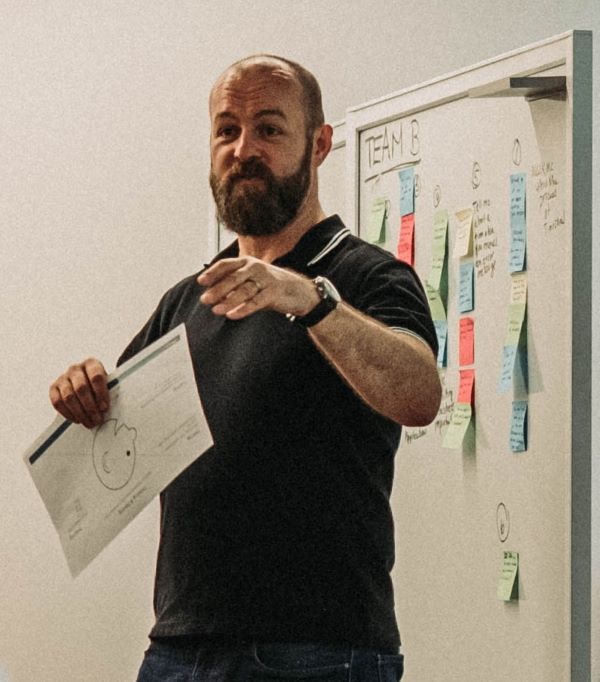
That allows us to elevate up from that to the next level of experience we’re trying to solve. For me, it shifts and helps elevate what that means. That would be my first one. Please don’t equate that design or user experience is only about the URI. I think the second one would be that while you will have people with experience, skill, and talent in this area as a practice craft, they need to be in the room and helping orchestrate it.
Design is most effective when it’s a team sport, when it’s collaborative. I’ve never seen it be very effective when, no matter how talented those people are, they go off on their own to craft something and then just try and share the results of it back. It’s far more powerful when people go through that whole experience themselves to understand how we came up with those ideas, with those visions, and then ultimately those designs for those solutions. It has far more longevity when it’s done that way.
On that note, I’d like to thank you.
Thank you very much for having me, Alex.
Thank you very much.
—
That’s it for this episode. In this episode, we got a first-hand expert account of what it takes to deliver human-centered innovation in an era of rapid technological change.
Important Links
About Glen Finch





